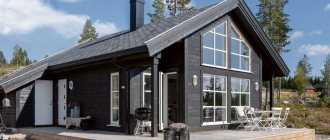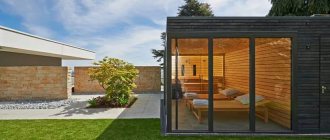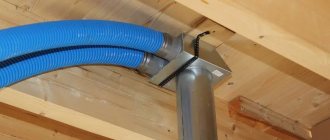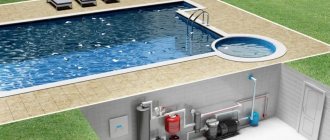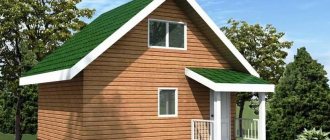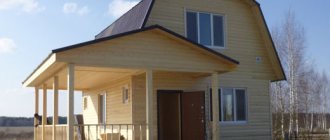Today we will talk about such a necessary room as a basement in a garage. For what purposes it can be used, everyone decides for themselves, and we will outline the main points and nuances of its construction. Having understood the information received, you will understand what the masters do. In addition, you will be able to ask intelligent questions regarding the design of the basement and the technology of its construction.
Cellar in the garage Source advicee.ru
Potbelly stove in the garage
There is a 5*6 garage with a full floor basement. Height approximately 2.5-3 m + 2 m basement. There is a homemade potbelly stove, approximately 50 liters in volume. I don’t really want to install it inside the garage itself, because... There isn't really enough space. So I wondered. What if you install a stove in the basement? Here are the advantages I see (in theory): 1. Dry basement (most likely it will be drier than it is, as it seems to me, because everything will warm up.) 2. More uniform heating of the main garage room (after all, warm air still rushes upward, so why not to lose it under the ceiling, but to be able to pass it throughout the entire area.) 3. Greatest fire safety (nothing is stored in the basement except brick walls and sand) 4. Reasonable use of free space.
Drawing up the right project
Before setting up an underground garage, a project is developed to determine the location and optimal size of the garage.
Location
First, determine where the vehicle storage room will be located. Experienced experts advise placing it in a private house, on the ground floor, which is recessed underground. It is convenient to use such underground garages in the summer, as they have a cool temperature.
However, for motorists who often repair cars, semi-basements are not suitable. It will not be possible to make a deep hole in them to repair the car’s suspension and its underbody. Therefore, above-ground garages are more suitable for auto mechanics.
Dimensions
When drawing up a project, the dimensions of the future garage space are determined. There are several factors that are taken into account when calculating the dimensions of a structure. The main one is the size of the private house under which the garage is located.
You also need to take into account the number of cars that will be stored in it. To store one vehicle, the length must be six meters, the width must be four meters and the height must be two meters.
Making a GARAGE out of a garage - Part 16 - Upgrading the stove and pit opening
Now the time has come to tell you about the most “delicious” =)) As some of you may remember, in Part 01 I installed a regular potbelly stove. Everything would be fine, but time passed and the horizontal section of the pipe was slowly overgrown with soot. And as a result, the stove began to smoke more and more often, and in the winter it was covered with frost a couple of times so that we had to heat it with the door open to melt the snow in the chimney))) This is where we had to film the cartoon “hedgehog in the fog” =) ) And once again, poking around on the Internet, I came across this site bullerjan.su. I was interested in this copy - bullerjan.su/order/4. I read about these stoves in general and decided to take a look around the local stores to get a price estimate. And not in vain, because. The same stove in retail cost us almost 13 thousand, and when ordering from the website (at the time of purchase 7600) + delivery by Business Lines it came out to 8 thousand. I ordered it, it was delivered, and it stayed with me for almost six months. Now her time has come. Since I already had a hole for the pipe to the basement, all that remained was to make it in the roof. Due to the fact that, according to the recommendations, a chimney needs to be at least 4 meters in order to have draft, I coped with this parameter with a bang and the total height was 6 meters, i.e. four meter and two meter sandwich pipes. Sandwich pipes are needed for the outdoor part of the chimney so that less condensate accumulates. And so, the hammer drill of course “sweated” a couple of times, but it ate through the slab
The diameter of the hole turned out to be more than 200mm, so that there was still room for the solution. Because of the roof, we had to move the hole a little to the side, because... The center of the pipe in a horizontal position extended along the very edge (second photo), but this is not critical. First, I assembled the chimney “in weight” in order to center the pipes and estimate the height of the pipe relative to the roof ridge. I fixed the sandwich pipe in the slab and filled it with solution.
When the solution had set, I coated the joints with heat-resistant sealant and put everything back together. But before putting the stove in place, I whipped up a stand for it, because... The oven should not be placed directly on the floor. I blew it out with oven paint.
Depending on the configuration of the stove, because There is one with a chimney outlet at the top and at the back, mine is at the back, the chimney is installed in different ways. In my case, a tee is first put on the stove outlet, on the bottom side of which a plug is placed with a faucet to drain the condensate, and the chimney itself is raised from the top. So I did. That's actually the culprit
On the street side I stuck a second sandwich pipe and an umbrella with wind protection
I also decided to completely fill the hole between the garage and the basement.
Well, what can I say based on first impressions. An ordinary potbelly stove, it warms you as you heat it, but with a couple of bonuses! The first is convection. Maybe it’s not so noticeable, or maybe I haven’t realized it yet, but it cooks well from the pipes, the traction is there. True, I didn’t find technical data with information about the volume of pumped air, but I think a lot depends on the temperature in the firebox. And the second bonus is the burning duration. This is where she really made me happy! A real example: while tinkering in the garage, I lit the stove, before leaving at the beginning of the first night, I put on a full firebox, put it in smoldering mode (this is when all the valves are closed) and left. Arriving at the garage at the beginning of the second day (!), I went down to the garage and realized that it was somehow too warm (usually by this time the room had time to cool down. I went up to the stove to break the unsmoldered coals and realized that warmth was wafting from the stove. I felt and really! It's still warm, not hot, but warm! Without hesitation, I chopped some wood chips, threw them in, opened the valves, the draft started, the coals got hot, the wood chips caught fire and I threw in more wood...beauty))) On average, the firebox lasts for 5 hours , but it all depends on the firewood: how dry it is, the type of wood (birch, coniferous or cutting boards), the temperature in the room, etc. In terms of temperature, I can say that it catches up quite quickly if you fire it up to full capacity, comparable to a regular potbelly stove, and in smoldering mode, for example, yesterday it smoldered for about 4 hours; the thermometer in the basement was +20, and in the garage itself it was +18, and this is at taking into account that the garage door was open 70% of the time. Overall I'm happy. Yes, not budget, but very convenient! Wow, well, I wrote it down)) But there is one more question on the recording agenda! More precisely, the solution is the hole opening. The fact is that initially two corner frames were stuck in the opening, the first one held the garage floor itself, and the second one was made for the “second” floor, for the purpose of thermal insulation from the basement. But because The meaning in it disappeared, then I decided to dismantle the frame of the “second” floor. And at the same time raise the corner of the main one, because Apparently, when they laid the boards, they were raised too high in level, I struggled with this in the last post. Because of this, the boards lay too low relative to the main floor and a rather noticeable step was obtained. I lifted the corner, drilled holes in it and leveled it with the boards
But I had to raise it almost 2-3 cm and in this position I secured it with self-tapping screws at the end of the board
Because the frame consisted of two C-shaped parts; I welded them together at one end, at the same time making a side for the solution that was poured in the previous part.
And I covered this entire gap with mortar so that the corner would not “play” when hit by a wheel.
Now it’s not perfectly level, but the step is much smaller! And I put the frame from the “second” floor on the edge of the jamb, all from the same previous entry))) And in addition to modernization, the stairs to the basement were modernized. Increased the steps! I solved a channel that had been lying around for a long time and welded it to the existing steps.
Pros and cons of space under the house
Like all types of garages, basement structures have their advantages and disadvantages. It is necessary to familiarize yourself with them in advance to understand whether it is worth building a garage in the basement under the house.
The advantages of basement-type buildings include the following:
- Compactness. A building with a garage located underground looks much more compact, since there are no extensions near it.
- Space saving. The garage, located on the ground floor, helps to save free space on the plot. Therefore, underground premises are popular among owners of summer cottages with a small area.
- Protection from the cold. Many people believe that basement buildings are the coldest, but this is not true. Their base is located much lower than where the soil freezes, and therefore the premises are protected from cold and temperature changes.
These buildings also have several disadvantages that every person should become familiar with before arranging garages under the house. These include:
- Difficulty in carrying out construction work. Building an underground car garage on your own is not easy, since to create it you will have to dig a deep pit.
- High humidity levels. A serious problem and main disadvantage is dampness. To get rid of it, you will have to carry out waterproofing work using high-quality building materials.
Correct installation of the stove in the garage
For proper operation of the stove, for the entire period of its operational life, you need to know how to properly install the stove in the garage. For reliable protection against a possible fire, you need to carefully determine the placement location, the method of outlet of the chimney, and study some installation rules.
Content:
Fire safety rules
Many people ignore safe installation rules, thereby endangering people and property around them. To ensure safety during operation of the stove, you should strictly adhere to fire protection rules and observe the correct installation of the stove in the garage.
To avoid a possible fire, you should adhere to the rules given below:
- The floor and nearby walls must be made of non-combustible material: concrete, brick, metal or ceramics. Special heat-resistant plates made of fire-resistant material are also used.
- The stove itself must be made of reliable and proven materials.
- Under no circumstances should there be any substances or materials near the stove that are easily flammable or may explode.
- The garage must have normal ventilation to ensure removal of combustion products in case of smoke.
- You should not install the stove close to the car; the distance should be no less than 1.5 meters.
In fact, garage ventilation should be a top priority. Due to insufficient oxygen, a fire can burn weakly, causing serious carbon monoxide poisoning or other serious and tragic consequences.
Exhaust ventilation must be present and in good condition. This will protect the garage from fire and prevent people present from getting hurt.
Where is the best place to install a stove in the garage?
When choosing the best place to install it in the garage, you should choose to place it in the corner of the garage, preferably on the opposite side of the gate.
This placement will allow for more efficient heating of the entire garage area and prevents the garage from quickly cooling when the door is opened. For safety, the chimney pipe running along the walls should be located at least 0.5 meters from the wall.
If the wall in the garage is built of wood, then the distance should be increased to a meter, and the wood should be protected with any fire-resistant material.
If installed near a gate, the installed stove should be no closer than 1 meter from the gate; this is necessary to ensure safety if the casing is made of wood.
How to properly install a stove in a garage?
After choosing the installation location, before starting installation, you need to protect the base from accidental loss of coals by placing a steel sheet under the stove, or erecting a brick base. If a concrete floor has been screeded, the stove can be installed directly on it.
To increase heat transfer time and at the same time safety, red brick walls are built around the stove. This increases the operating time of the stove, it cools down much more slowly, allowing you to receive heat after complete combustion of the fuel. This method is used mainly for square-shaped stoves; in round stoves, radiator plates are used throughout the body.
Let's take a closer look at how to properly install a stove in a garage:
- When you have decided on the installation location, you need to prepare the foundation for its installation; the weight of steel furnaces is small, but the foundation must be strong enough. Under the installation site, soil is selected to a depth of 40-50 centimeters, the dimensions are calculated based on the stove itself (15-20 centimeters wider).
- Next, the dug hole is filled with a cushion of sand and crushed stone and compacted well.
- After which a wooden formwork is constructed and securely fastened.
- Next, a cement-sand mortar with crushed stone is prepared and concreted.
- When the base has hardened, we install the oven itself, according to the provided calculation.
- If necessary, we make a protective screen around the stove.
- Depending on the conditions, we make a passage hole for the chimney pipe in the wall or in the roof.
- The last stage of installing the stove will be the installation of the chimney (this will be discussed later).
Chimney outlet through the wall
There are two options for venting the chimney: through the garage roof or through the wall. Now we will consider both options in detail.
Exiting the chimney through the wall has a number of advantages:
- It does not require high-quality waterproofing of the pipe passage, unlike the passage through the roof.
- Relatively simple and convenient installation.
The disadvantages include:
- Worse draft compared to direct installation of the chimney.
- The presence of turns and bends makes cleaning difficult.
- It needs more insulation.
Schemes for installing a garage stove through the wall (2 options):
Installation Tips:
- Chimney installation begins with the stove. After preliminary assembly, the location of the chimney passage in the wall is marked. Next, the technological hole itself is prepared. Afterwards, the final installation of the pipes is carried out in the garage with the elbow or tee leading out to the street.
- It is advisable to use a tee with an inspection removable cover for ease of cleaning. It is worth noting that if the walls of the garage are made of wood, a fire passage must be constructed from a steel box, where the space around the pipe is filled with non-combustible material.
- Installation of the chimney pipe on the wall is carried out using special fasteners strictly vertically; a fungus is installed at the end of the pipe to protect it from moisture. The length of the chimney depends on specific conditions, the main condition being sufficiently good draft.
Chimney outlet through the roof
Diagram of the outlet of a stove chimney for a garage through the ceiling/roof:
As in the case of installing a chimney through a wall, when installing through a ceiling, preliminary assembly is first done in order to accurately mark the future passage through the roof. Once the installation hole is made, the steel penetration through the roof is installed.
Next, in the same sequence, the pipe is assembled and the passage through the roof is laid with non-combustible material. The passage of the chimney through the roof requires reliable waterproofing so as not to encounter leaks in the future. As in the first option, you should protect the pipe from moisture getting into it and insulate the outer part of the pipe to reduce the formation of condensation.
Conclusion
From all of the above, we can conclude that the installation of a stove in a garage must be done correctly, and all fire safety standards must be observed. Not only the long and normal operation of the heating device itself, but also safety depends on the correctness of the work on installing the stove.
You should strictly adhere to all rules and requirements to ensure normal, trouble-free operation of the furnace. It is important that before firing the stove for the first time, you must carefully ensure that there are no leaky joints and connections, and if the slightest defects are detected, they should be eliminated immediately. This will help protect against carbon monoxide poisoning and fire.
If everything is done correctly, the stove will delight and provide warmth for many years. You will be able to forget forever about working or relaxing in the garage, which previously looked more like an ice palace. In addition, the stove still remains a very efficient and economical heating device.
In addition to everything, a stove in the garage can be used for cooking. You can equip it to heat water and use it for your needs. Based on the stove, you can make full-fledged water heating for your garage; of course, this will only be appropriate in cases where the garage is visited every day. If the garage is not visited often, it is not worth using water heating as an addition to the stove.
Common mistakes and useful tips
*
Before insulating the basement in the garage, it is necessary to carefully level the surfaces of the walls, floor and ceiling. Some people neglect this process and make a big mistake. After all, most coatings are applied to a hard, flat surface using anchors or adhesive mixtures.
Leveling walls with plaster
For leveling, plastering is most often used, with the help of which:
- the durability of the installation is ensured;
- all inaccuracies in the structure are eliminated;
- surfaces acquire the necessary hardness.
Another common mistake is poorly thought out electrical wiring. Before plastering, it is imperative to lay a cable or wire for further installation of switching devices and lamps. The open installation method, even in corrugated plastic or metal pipes, is still undesirable due to the fact that the room has high humidity.
Important advice! A dark and damp basement is perfect for the growth of various types of fungi. Before insulating the walls and ceiling in the garage cellar, they need to be primed.
Nowadays there are many different materials on sale for this purpose with antibiological additives that inhibit the development of mold and bacteria. In addition, primers contribute to the non-flowability of the plaster and its long-term preservation.
If the basement has just begun to be built, then insulation is carried out from the inside and outside. This process is complex and costly in time and effort, but necessary. The cellar is dug around the perimeter and a layer of roofing material or bitumen-based material is laid.
How to make a stove in the basement of a garage correctly
You are using an outdated browser. This and other sites may not display correctly. You need to update your browser or try using a different one.
Used for gluing decorative elements made of ceramics, stone or other mineral materials to heated surfaces. Recommended for masonry, cladding, putty, grouting and repairing stoves, boilers, fireplaces and sealing cracks in chimneys. The mastic is resistant to water and temperatures up to +1300°C. Excellent adhesion, high elasticity, ease of use, low consumption.
Calculation of basic parameters (with drawings and dimensions)
High efficiency of a potbelly stove can only be achieved if all the main design parameters are correctly calculated.
Pipe
In this case, the diameter of this element is very important. The throughput of the chimney should be less than the productivity of the furnace firebox, which is the main distinguishing feature of a potbelly stove. This will allow warm air not to immediately leave the stove, but to linger in it and heat the surrounding air.
It is very important to make an accurate calculation for it. The diameter should be 2.7 times the volume of the firebox. In this case, the diameter is determined in millimeters, and the volume of the firebox in liters. For example, the volume of the combustion chamber is 40 liters, which means that the chimney diameter should be about 106 mm.
If the potbelly stove provides for the installation of grates, then the height of the firebox is calculated without taking into account the volume of this part, that is, from the top of the grate.
It is very important to correctly calculate the diameter of the stove pipe
Screen
It is very important to force the hot gases not to cool, but to burn out completely. In addition, the fuel must burn through partial pyrolysis, which requires extremely high temperatures. A metal screen located on three sides of the stove will help to achieve a similar effect. It should be placed at a distance of 50–70 mm from the stove walls, due to which most of the heat will return to the stove. This air movement will give the necessary high temperature and protect against fire.
The screen of a potbelly stove made of red brick is capable of accumulating heat
Litter
It definitely has to be there. There are two reasons for this:
- some of the heat is radiated downwards;
- the floor on which the stove stands gets hot, which means there is a risk of fire.
The litter solves these two problems at once. As such, you can use a metal sheet with a projection of 350 mm (ideally 600 mm) beyond the contour of the furnace itself. There are also more modern materials that do an excellent job of this task, for example, a sheet of asbestos or kaolin cardboard, at least 6 mm thick.
You can use an asbestos sheet for bedding under a potbelly stove.
Chimney
Despite all the calculations, gases sometimes escape into the chimney not completely burned out. Therefore, it must be done in a special way. The chimney consists of:
- the vertical part (1–1.2 m), which is recommended to be wrapped in thermal insulation material;
- hog (slightly inclined part or completely horizontal), 2.5–4.5 m long, which should be 1.2 m from the ceiling, which is not protected with heat-resistant materials (1.5 m from the wooden surface), from the floor - by 2.2 m.
The chimney must be vented to the street
Photo gallery: diagrams of a potbelly stove for a garage
How to make a stove in the basement of a garage correctly
You are using an outdated browser. This and other sites may not display correctly. You need to update your browser or try using a different one.
Used for gluing decorative elements made of ceramics, stone or other mineral materials to heated surfaces. Recommended for masonry, cladding, putty, grouting and repairing stoves, boilers, fireplaces and sealing cracks in chimneys. The mastic is resistant to water and temperatures up to +1300°C. Excellent adhesion, high elasticity, ease of use, low consumption.
Design Features
For those who want to build a garage with a cellar, the project is drawn up taking into account some rules for constructing the structure:
- The standard cellar depth is up to two meters.
- If groundwater is close or there is wet soil, the walls must be made of waterproof monolithic concrete or a material with a very high density.
- If the soil is dry, it is enough to make walls from standard lightweight asbestos-cement corrugated slate roofing sheets. They are installed in two layers and fixed with self-tapping screws or self-tapping screws to a wooden frame, which increases the strength of the structure. They are glued together using bitumen mastic or cement-casein glue.
- The waterproofing of the room is carried out with hot bitumen; the enclosing structures must be coated with it twice.
Advice: Before doing this, do not forget to treat the surfaces with primer.
- An installation with two channels of a ventilation pipe or a hatch with a grill ensures air circulation. To insulate the grille during low temperatures, you can use an old cotton blanket.
Self-made dehumidifier
Before starting work, you need to determine how exactly moisture will be extracted from the air.
Desiccant desiccant
They are cut into two parts, and holes are made in the bottom with a hot awl or knitting needle. The upper half is placed in one part of the bottle with the neck turned down, and the cork is also pierced in several places. Apply silicone gel, about 250 grams.
With the second bottle, they carry out other work - they cut off the bottom, put a cooler inside, which blows into the cut hole. A pressure unit is made at a distance of 7 or 10 centimeters from the bottom, after which the structure is placed on a bottle with gel.
All joints are sealed with tape. The cap of the second bottle is removed or replaced with gauze. This ensures free air flow.
The fan forces air masses into the desiccant, and then the air comes out through the gauze. If the gel loses its absorbent properties over time, simply dry it in the oven for about 3 hours. Thus, air dehumidification occurs without noise and is quite effective.
Condensing dryer
You will need an old refrigerator, screws and sealant, a simple heater, computer coolers, plexiglass and a rubber hose. Remove the door from the refrigerator, setting the plexiglass sheet to size, keeping the thickness to 3 mm.
Fans are mounted in such a panel, retreating from the edges by 30-40 centimeters. The fan grilles are treated with sealant and fixed with self-tapping screws. This will be the supply part of the system, pushing air inside the refrigerator.
The top of the plate is equipped with several small holes to allow cooled, dry air to escape. The area of all openings must be equal to the size of the fan.
Alternatively, the air can be removed by a second fan, which is placed on top. This will dry the air by 8%, reducing the temperature by 5 degrees.
This model can be further improved by adding a heater. It is mounted at the top of the device or on plexiglass
It is important to make an intersection of the air flows entering through the fan inside and the dried air flowing out
Although outwardly such a dehumidifier for the basement does not look attractive, it significantly saves the cost of purchasing ready-made devices and effectively removes moisture from the basement.
Proper air exchange device
For the most competent ventilation device in the garage basement, the following points must be taken into account:
The most effective is the exhaust system, which ensures the circulation of air masses even in summer. When using a fan in a circuit, care should be taken to insulate it and protect the wiring from moisture that forms during the process. If the area of the room is less than 40 square meters, and food is stored inside, it is necessary to install a hood. When choosing equipment, it is important to understand which fan to take: a device that is too powerful consumes more energy, and a model that is too weak does not allow all the moisture to be completely removed.
Ready-made dehumidifiers
Basement dehumidification is based on increasing the dryness of the air and drawing moisture out of the walls. Typically these are fans that circulate raw air to the evaporator. There it cools and dehydrates. The flow passes through the condenser, which is accompanied by heating. And the output is dry and warm air, filling the room.
Air exchange
The most significant characteristic of the device, on which the efficiency of the equipment depends. Determines the number of cubic meters of surface to be drained per hour of operation. The air exchange in the room should exceed the size of the room several times. Only under this condition will an acceptable result be achieved.
Operating temperature
A condensation type dryer is used at 15 degrees Celsius. If the temperature is lower, about 10 degrees, then the device will spend too much energy on defrosting and heating the air. In this mode, it would be optimal to use an adsorbing type of device.
Energy costs
The operation of the device requires prolonged consumption of electricity, which will increase electricity bills and cause certain loads on the electrical wiring. Specifications for each unit may vary depending on the model of the device and its manufacturer.
Condensate collection container
The container for collecting moisture is designed for comfortable use of the device; the larger it is, the less often you will need to drain it. If there is a sewer drain nearby, then you can lower the drainage pipe directly into it, removing moisture from the tank directly.
In order to save money on purchasing ready-made equipment and, if you want to gain new experience in developing devices, you can make dehumidifiers yourself.
We recommend to buy
Reasons for rising humidity
It is better to eliminate dampness in the basement immediately than to deal with its consequences later. The reasons may be the lack of proper air exchange, ventilation and window openings, moisture absorption by the walls of the room, poor or insufficient waterproofing protection, clogged drainage, abundant flood or groundwater.
Typically, spores of fungal infection and mold are present in all rooms, only they are inactive. But as soon as conditions for their reproduction appear (temperature above 20 degrees Celsius with a humidity of 80%), they begin to cover all accessible surfaces.
To successfully combat such infections, you need the right dehumidifier, which will change the air exchange parameters in the basement and prevent the development of pathogenic bacteria.

